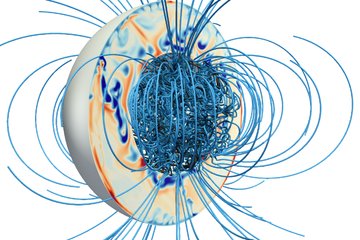EDI - electron drift instrument
Purpose of EDI instrument
EDI measures the drift velocity of artificially injected electron beams. From this drift velocity, the perpendicular electric field and the local magnetic field gradients can be deduced when employing different electron energies.
MPS contribution
MPS team makes production of intermediate files, ancillary data and Cluster Science Archive products. The primary location of EDI instrumentation team is The University of New Hampshire (UNH).
Examle of Science using EDI
Monitoring of penetration of solar material into the magnetosphere via study convection cells of a particular state of matter called plasma, over the polar caps, at an altitude of a few hundred kilometers. In this region, called the high-latitude ionosphere, the nature of these plasma cells in terms of their number, shape, size, and location, strongly depends on the response of the magnetosphere to the orientation of the interplanetary magnetic field (IMF) generated by the Sun. The pattern of polar cap convection cells is a good tracer of the Sun-Earth connection.
More info can be found on ESA highlight page.
One more example of ion outflow study using EDI (in Norwegian).
Publications using Cluster (EDI, RAPID, CIS and etc).
List of EDI products and their content
EDI data formats are CEF and CDF. The CEF naturally is a text file. The CDF is a NASA binary format file. Under the refernce one can find the CDF structure and tools to manipulate the CDF files. The EDI User Guide AT CSA can explain EDI products in detail. See also other documentation at Cluster Science Archive.
|
Product name |
Format |
Content |
|
PP, SPIN |
CEF, CDF |
Electric Field, Drift Velocity, status, errors |
|
SP |
CEF, CDF |
Electric Field, Drift Velocity, status, errors |
|
PPPlus |
CDF |
Electric Field, Drift Velocity, status, errors, drift step |
|
AE, AEDC |
CEF, CDF |
Ambient Electron & Corrected Ambient Electron Data |
|
MP |
CEF,CEF |
Electric Field, Drift Velocity, status and errors |
|
EGD |
CEF |
Electron time-of-flight, error and GDU-flag |
|
QSTAT |
ASCII |
EDI detection efficiency (beam tracking performance) |
|
CLIST |
CEF |
Time intervals of EDI operation modes (WW/AE) |
|
AEC |
ASCII |
Used to correct raw, ambient electron counts for theta/phi |
|
CRF |
CEF |
Code repetition frequency, beam current index |
|
QZC |
CEF |
raw electron counts (for PA=90°, E=0.5/1 keV), detector |
|
MSF |
binary |
Merged Science Files |
How to download EDI data
- The first option is to download EDI data at Cluster Science Archive. It is possible here to use a web-interface("select date, product and click to download"), http query, wget, scripts in matlab and idl. All EDI products are available. The downloaded EDI data format here is a text file and cdf file.
- EDI data at MPS, cluster database. The available EDI products are pp files. The available data format is cdf file
- You may always write your questionsd to our archive scientist: rashev@mps.mpg.de
Principle of Operation

The electron drift instrument measures the displacement of a weak (< 1 µA) beam of test electrons, after one gyration in the ambient magnetic field that is induced by electric fields or magnetic gradients. This displacement (the drift step) causes the beam to return to a detector on the spacecraft only when emitted in one of two precisely determined directions. By employing two beams and two detectors, these directions can be monitored continuously and the displacement obtained by triangulation. Figure 1 illustrates the situation. For small magnetic fields the triangulation degenerates and the displacement is obtained instead from the difference in the travel times of the electrons in the two beams. As a by-product, the measured times-of-flight provide a precise measurement of the magnetic field magnitude. The electron energy is switched between 1.0 and 0.5 keV. As the electric field drift does not depend on electron energy, while the gradient drift does, this scheme allows to separately determining the electric fields and the magnetic field gradients. The diagram in Figure 2 shows characteristic relations between the magnitude of the ambient electric and magnetic fields and the drift step.














